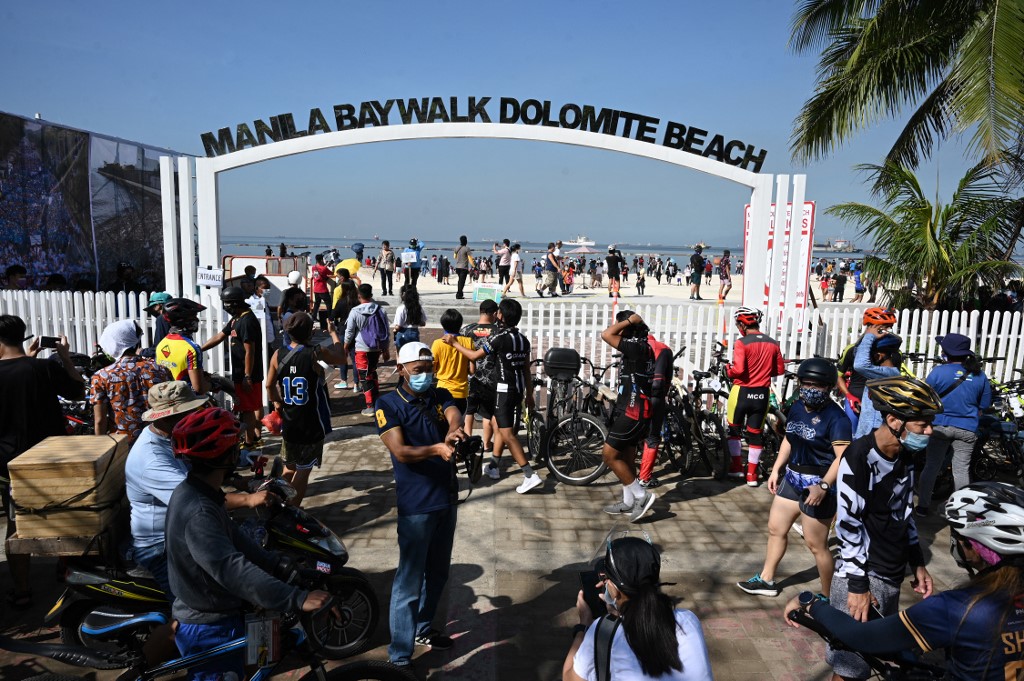DILG seeing looser Metro curbs by November

People trooping to Manila Bay’s “dolomite beach” along Roxas Boulevard in Manila city on October 17, 2021, a day after authorities eased its quarantine restrictions in the nation’s capital. (File photo by Ted ALJIBE / AFP)
Metro Manila is highly likely to be placed under the less restrictive alert level 2 in November as COVID-19 numbers continue to improve, according to Undersecretary Jonathan Malaya of the Department of the Interior and Local Government (DILG).
The official cited the decline in the number of infections as one of the reasons for the possible relaxation of community quarantine restrictions in the National Capital Region (NCR).
The decision on retaining or downgrading the alert level is on the Department of Health (DOH) and the technical working group on data analytics of the Inter-Agency Task Force against COVID-19, which was to meet on Thursday.
“I can see the consistency in our data, the decrease in our cases has been dramatic: 48-percent decline in our cases in the past two weeks. If this trend continues, we can look at a lowering of the alert level soon,” Malaya said in an interview on ANC on Thursday.
Under alert level 2, establishments can operate up to 50 percent of their capacity for indoor areas, which can be raised to 60 percent if they have the safety seal issued by the government, and 70 percent for outdoors.
Article continues after this advertisement“This is certainly good news for business establishments as they would be getting closer to their ultimate goal of operating at full capacity. This is important for businesses as this would give them a chance to cover operating expenses such as workers’ salary and supply, among others,” Presidential Adviser for Entrepreneurship Joey Concepcion said on Thursday.
Article continues after this advertisementNot too fast
While there have been improvements in some of the COVID-19 numbers of new areas placed under the alert levels system, the DOH would like to monitor the situation for a longer period, according to Director Alethea de Guzman of the agency’s epidemiology bureau.
The government recently expanded the alert levels system first piloted in Metro Manila to the Calabarzon, Central Visayas, and Davao regions.
De Guzman said that in monitoring the pilot areas, the DOH checks on the average daily attack rate, the two-week growth rate, healthcare utilization rates as well as improvements in the implementation of the Prevent-Detect-Isolate-Treat-Reintegrate (PDITR) strategy.
“As of now, we can report back that there are areas where we see improvements in their case data and utilization data, but it’s been only one week,” De Guzman said at the Laging Handa briefing on Thursday.
“It would be better to check on the effects of the policy shift on the areas where we expanded the (alert level coverage) after one or two weeks, and that is when we can report if we’ve seen improvements in their PDITR indicators,” she said.
The Philippines is now at low risk for COVID-19, but De Guzman stressed the need for continued vigilance and compliance with health protocols to keep the numbers down, especially since people are more mobile now.
Optimism
The private sector has been pushing for the easing of restrictions to help businesses recover.
On Thursday, Concepcion again pressed the government to put Metro Manila under alert level 2 as COVID-19 cases were now on a downtrend.
“Business establishments are looking forward to the possibility of declaring alert level 2 in Metro Manila as it would lead to additional capacity to accommodate more customers. This would translate to more income that could help them recoup their losses during the pandemic,” Concepcion said in a statement.
OCTA Research Group, which recently signed a partnership with Concepcion’s Go Negosyo to advise the latter on COVID-19 data issues, was quoted in the same statement saying Metro Manila was currently under low risk as it tallied just 953 cases a day on a seven-day average from Oct. 20 to 26.
OCTA added that Metro Manila recorded a positivity rate of 6 percent while its healthcare usage was at 35 percent. Based on the current trends, OCTA said cases could decrease to less than 2,000 a day by the end of November.
Local gov’ts ready
Some local executives have also backed calls to ease quarantine restrictions in Metro Manila.
San Juan City Mayor Francis Zamora on Thursday said he would back the NCR’s downgrading to alert level 2 should the number of active cases continue to drop.
The city recorded a 90-percent decline in active cases from 1,123 in September to 110 as of Oct. 28.
Meanwhile, Muntinlupa City Mayor Jaime Fresnedi said the local government was ready if ever President Rodrigo Duterte would give his approval to the quarantine easing.
OCTA on Thursday also released a special report classifying Taguig City as a low-risk area after recording a seven-day average of 58 COVID-19 cases this week from 109 cases the previous week. —With reports from Roy Stephen C. Canivel and Jane Bautista
For more news about the novel coronavirus click here.
What you need to know about Coronavirus.
For more information on COVID-19, call the DOH Hotline: (02) 86517800 local 1149/1150.
The Inquirer Foundation supports our healthcare frontliners and is still accepting cash donations to be deposited at Banco de Oro (BDO) current account #007960018860 or donate through PayMaya using this link.